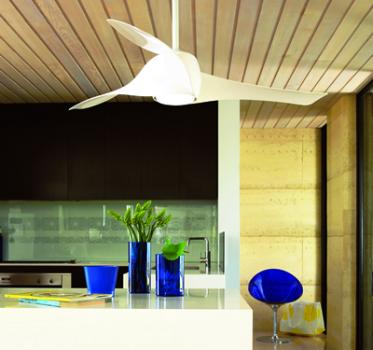Australia is known for its hotter-than-hot summers, so finding ways to cool your home without constantly relying on air conditioning is important. Not only will it save you lots of money, but it will also make your home more comfortable to live in.

Image courtesy of Beacon Lighting.
1. Ceiling fans
A ceiling fan can be a good addition to a home. By circulating air and creating a breeze effect, ceiling fans make it feel cooler. They also cost a lot less than an air conditioner, both to buy and to run. There are many types of fans you can use – portable, oscillating, box – but the ceiling fan offers the best results. One of the biggest advantages of a cooling fan is that it can be used in conjunction with an air conditioner to help prevent cool air from pooling on the ground.
If you live in a multi-storey home, you could also consider a whole house fan. This involves installing a fan into the ceiling of the highest storey in your house, which then extracts the warm air from the top of the house, and sucks cool air in through a network of vents in the lower levels of the house.
2. Curtains or blinds
As well as helping you to retain heat during winter months, curtains can be used to repel heat generated by the sun in summer. If you install blinds or shades that are a bright colour (like white), they will actually work as a reflector and minimise the amount of heat that comes in through your windows. Likewise, thicker, multi-layered and thermal backed curtains are more effective for keeping heat out. Having said that though, it’s far more effective to stop heat from getting inside in the first place using special glazings and films or exterior window shades.
3. Double glazed windows
On all windows that get direct exposure to the sun, you should consider double glazing or tinting. This will affect the quality of light you get inside your home, but it will also help to control how much heat is allowed in.
4. Awnings
Awnings are a great way to reduce heat gain through windows. When positioned properly, they reduce the amount of direct sunlight reaching the glass, without adversely affecting the quality of light that you get inside.
5. Turn off the lights
Certain types of lights, such as incandescent lamps and halogen downlights, produce a lot of heat. Avoiding these lights in the summer months will help reduce the heat in your home. Alternatively, you may consider switching them to energy efficient alternatives that run at a cooler temperature, like compact fluorescent lamps (CFLs).
6. Pick a colour
In the same way that lighter coloured curtains help to cool a home, lighter coloured walls and ceilings absorb less heat than darker ones. Avoid darker coloured surfaces.
7. Control humidity
In Australia, particularly up north, humidity is a force to be reckoned with. Humidity can make a room feel warmer than it actually is, so controlling it is an important part of staying comfortable. Avoid tasks that expel steam, like using your clothes dryer, ironing or cooking.
8. Insulate
Insulation in roof and wall cavities helps keep the heat out of your home. It acts as a buffer between the outside weather and the climate inside your home. During winter months, it traps heat inside your home, but in summer it can be equally as effective at preventing heat from getting in. The thicker the insulation, the better the result.
If you’re thinking of installing insulation in an existing home, make sure you hire a qualified professional and consult with an electrician. Badly installed insulation has the potential to create fires.
9. Plant some trees
If your room backs on to a yard or garden, a very simple and decorative way to reduce the amount of heat you get inside is to plant some trees outside. Over time the trees will grow and produce shaded areas, and reduce the amount of direct sunlight hitting your home.





